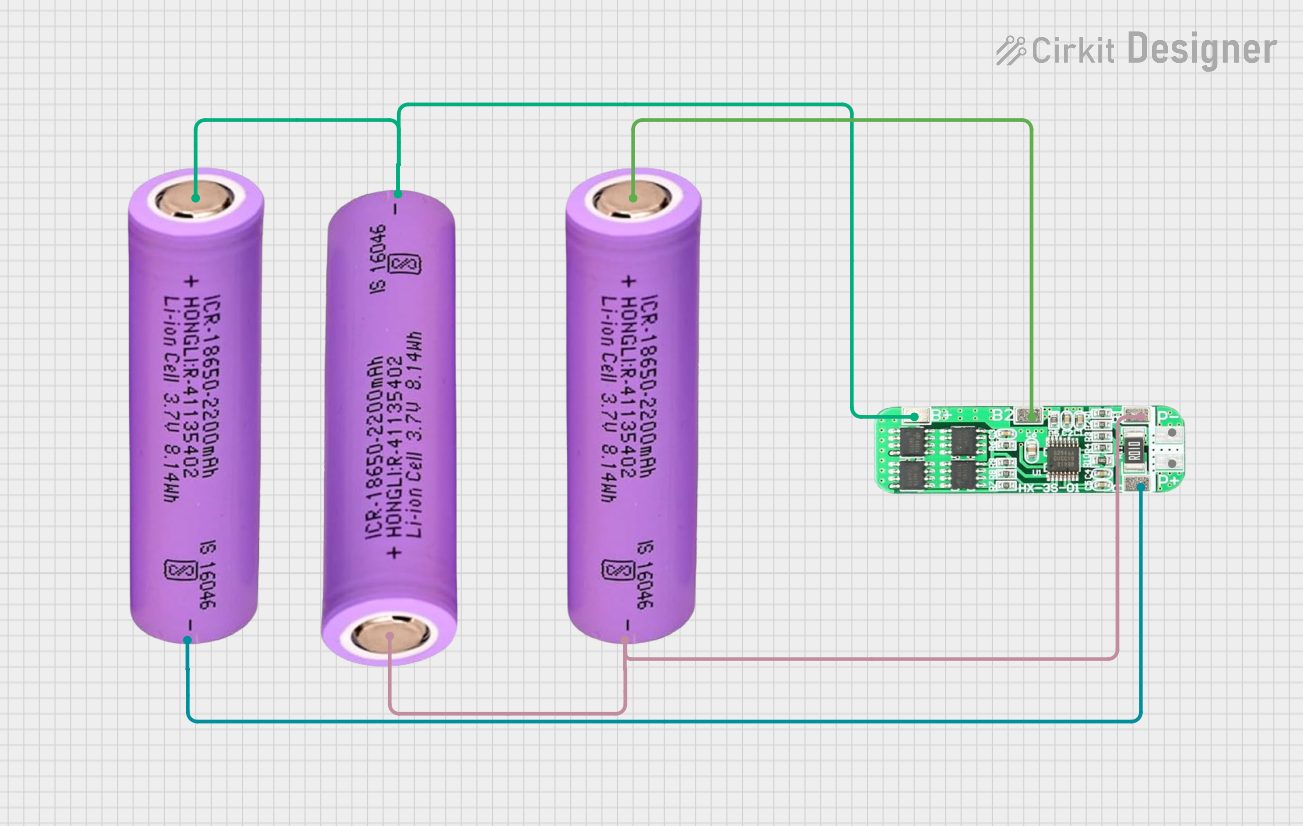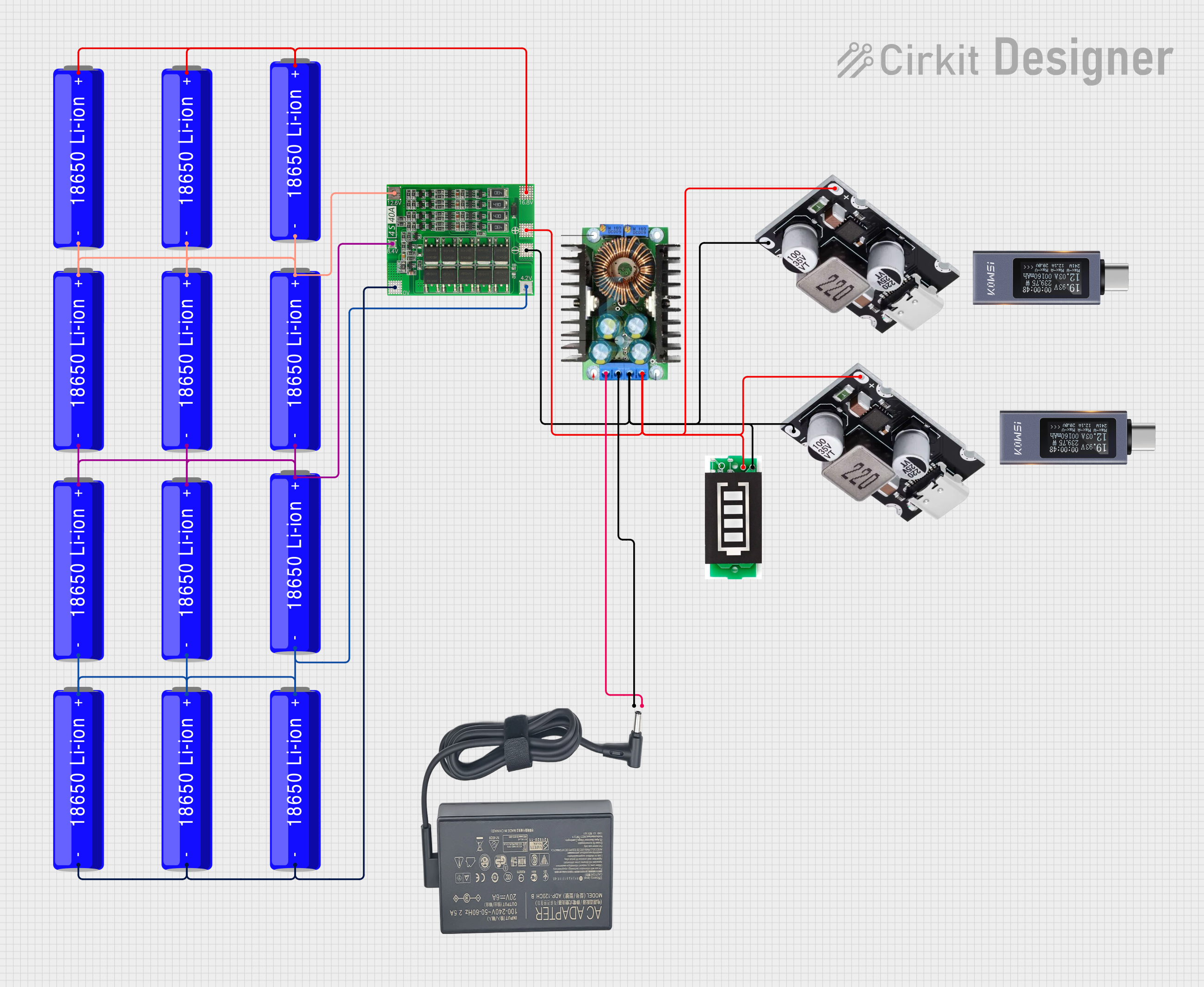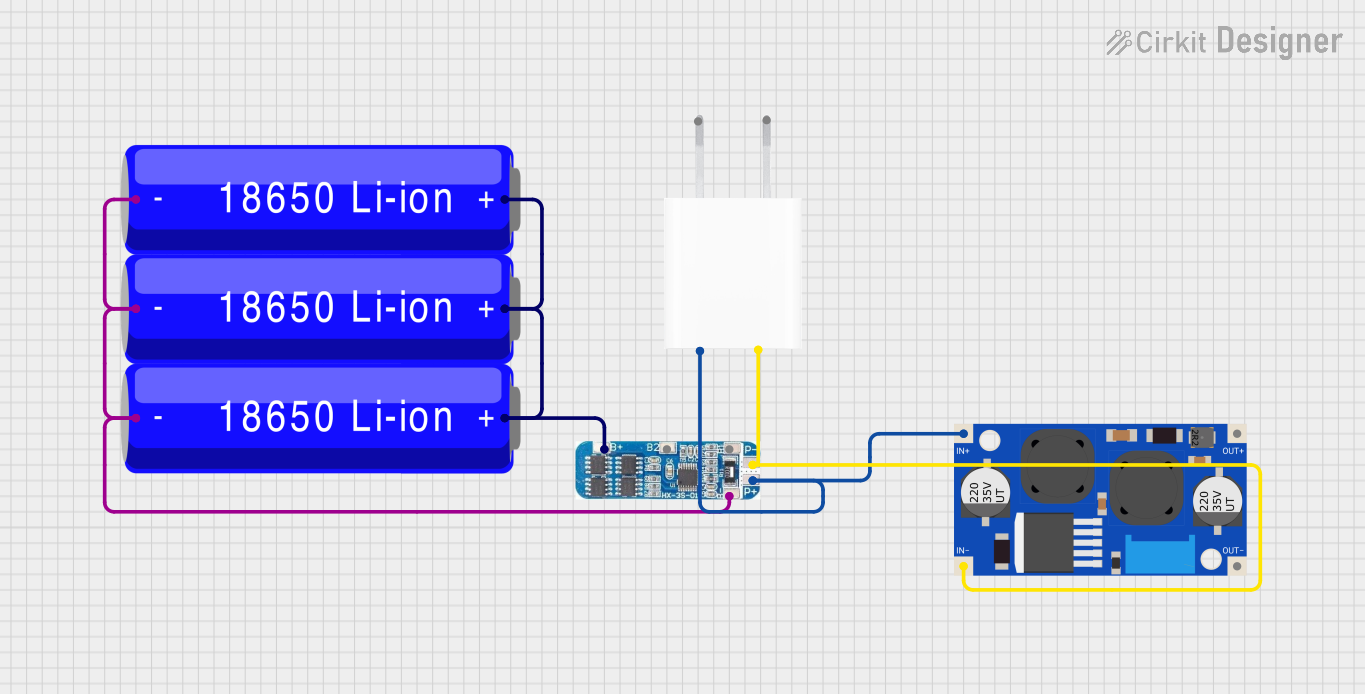
How to Use Li-ion 18650 Battery 3.7V 3400 mah: Examples, Pinouts, and Specs

 Design with Li-ion 18650 Battery 3.7V 3400 mah in Cirkit Designer
Design with Li-ion 18650 Battery 3.7V 3400 mah in Cirkit DesignerIntroduction
The Li-ion 18650 Battery 3.7V 3400mAh is a rechargeable lithium-ion battery with a nominal voltage of 3.7 volts and a capacity of 3400 milliamp hours (mAh). Known for its high energy density, long cycle life, and compact cylindrical form factor, this battery is widely used in portable electronics, power tools, flashlights, and electric vehicles. Its reliability and efficiency make it a popular choice for applications requiring lightweight and long-lasting power sources.
Explore Projects Built with Li-ion 18650 Battery 3.7V 3400 mah

 Open Project in Cirkit Designer
Open Project in Cirkit Designer
 Open Project in Cirkit Designer
Open Project in Cirkit Designer
 Open Project in Cirkit Designer
Open Project in Cirkit Designer
 Open Project in Cirkit Designer
Open Project in Cirkit DesignerExplore Projects Built with Li-ion 18650 Battery 3.7V 3400 mah

 Open Project in Cirkit Designer
Open Project in Cirkit Designer
 Open Project in Cirkit Designer
Open Project in Cirkit Designer
 Open Project in Cirkit Designer
Open Project in Cirkit Designer
 Open Project in Cirkit Designer
Open Project in Cirkit DesignerCommon Applications
- Portable electronics (e.g., laptops, cameras, and handheld devices)
- Electric vehicles and e-bikes
- Power banks and backup power systems
- Flashlights and LED lighting
- DIY electronics and robotics projects
Technical Specifications
The following table outlines the key technical details of the Li-ion 18650 Battery 3.7V 3400mAh:
| Parameter | Specification |
|---|---|
| Nominal Voltage | 3.7V |
| Capacity | 3400mAh |
| Maximum Voltage | 4.2V |
| Minimum Discharge Voltage | 2.5V |
| Standard Charge Current | 0.5C (1.7A) |
| Maximum Charge Current | 1C (3.4A) |
| Standard Discharge Current | 0.5C (1.7A) |
| Maximum Discharge Current | 2C (6.8A) |
| Cycle Life | ≥500 cycles |
| Operating Temperature | Charge: 0°C to 45°C, Discharge: -20°C to 60°C |
| Dimensions | 18mm (diameter) x 65mm (length) |
| Weight | ~45g |
Pin Configuration and Descriptions
The 18650 battery has two terminals:
| Pin | Description |
|---|---|
| Positive (+) | The positive terminal of the battery. Connect to the positive side of the circuit. |
| Negative (-) | The negative terminal of the battery. Connect to the ground or negative side of the circuit. |
Usage Instructions
How to Use the Component in a Circuit
Charging the Battery:
- Use a dedicated Li-ion battery charger with a constant current/constant voltage (CC/CV) charging profile.
- Ensure the charging voltage does not exceed 4.2V and the charging current is within the recommended range (0.5C to 1C).
- Avoid overcharging or deep discharging the battery to prolong its lifespan.
Connecting the Battery:
- Identify the positive (+) and negative (-) terminals of the battery.
- Use appropriate connectors or soldering techniques to securely connect the battery to your circuit.
- Include a protection circuit module (PCM) or battery management system (BMS) to prevent overcharging, over-discharging, and short circuits.
Discharging the Battery:
- Ensure the load current does not exceed the maximum discharge current (6.8A).
- Monitor the battery voltage and disconnect the load when the voltage drops below 2.5V to prevent damage.
Important Considerations and Best Practices
- Safety: Always handle the battery with care. Avoid puncturing, short-circuiting, or exposing it to high temperatures.
- Storage: Store the battery in a cool, dry place at a charge level of around 40-60% for long-term storage.
- Series/Parallel Connections: When connecting multiple batteries in series or parallel, ensure they are of the same type, capacity, and charge level to avoid imbalances.
- Arduino Integration: When using the 18650 battery with an Arduino UNO, use a voltage regulator or step-down converter to ensure the voltage is within the Arduino's operating range (5V or 3.3V).
Example: Powering an Arduino UNO with an 18650 Battery
To power an Arduino UNO using an 18650 battery, you can use a DC-DC step-up converter to boost the 3.7V to 5V. Below is an example circuit and code:
Circuit Setup:
- Connect the positive terminal of the 18650 battery to the input of the step-up converter.
- Connect the output of the step-up converter to the Arduino's 5V and GND pins.
Arduino Code:
// Example code to blink an LED connected to pin 13
void setup() {
pinMode(13, OUTPUT); // Set pin 13 as an output
}
void loop() {
digitalWrite(13, HIGH); // Turn the LED on
delay(1000); // Wait for 1 second
digitalWrite(13, LOW); // Turn the LED off
delay(1000); // Wait for 1 second
}
Troubleshooting and FAQs
Common Issues and Solutions
Battery Not Charging:
- Cause: Faulty charger or damaged battery.
- Solution: Verify the charger is functioning correctly and compatible with the battery. Check the battery for physical damage.
Battery Drains Quickly:
- Cause: Over-discharge, aging, or high self-discharge rate.
- Solution: Avoid deep discharges and replace the battery if it has reached the end of its cycle life.
Battery Overheats During Use:
- Cause: Excessive current draw or short circuit.
- Solution: Ensure the load current is within the specified range. Use a protection circuit to prevent short circuits.
Voltage Drops Below 2.5V:
- Cause: Over-discharge.
- Solution: Recharge the battery immediately. Use a BMS to prevent over-discharge in the future.
FAQs
Q: Can I use the 18650 battery without a protection circuit?
A: It is not recommended. A protection circuit ensures safe operation by preventing overcharging, over-discharging, and short circuits.Q: How do I know when the battery is fully charged?
A: The charger will typically indicate full charge when the voltage reaches 4.2V and the current drops to a minimal level.Q: Can I connect multiple 18650 batteries in series or parallel?
A: Yes, but ensure all batteries are of the same type, capacity, and charge level. Use a BMS to manage the pack safely.Q: What is the expected lifespan of the 18650 battery?
A: The battery can last for 500 or more charge/discharge cycles under proper usage conditions.